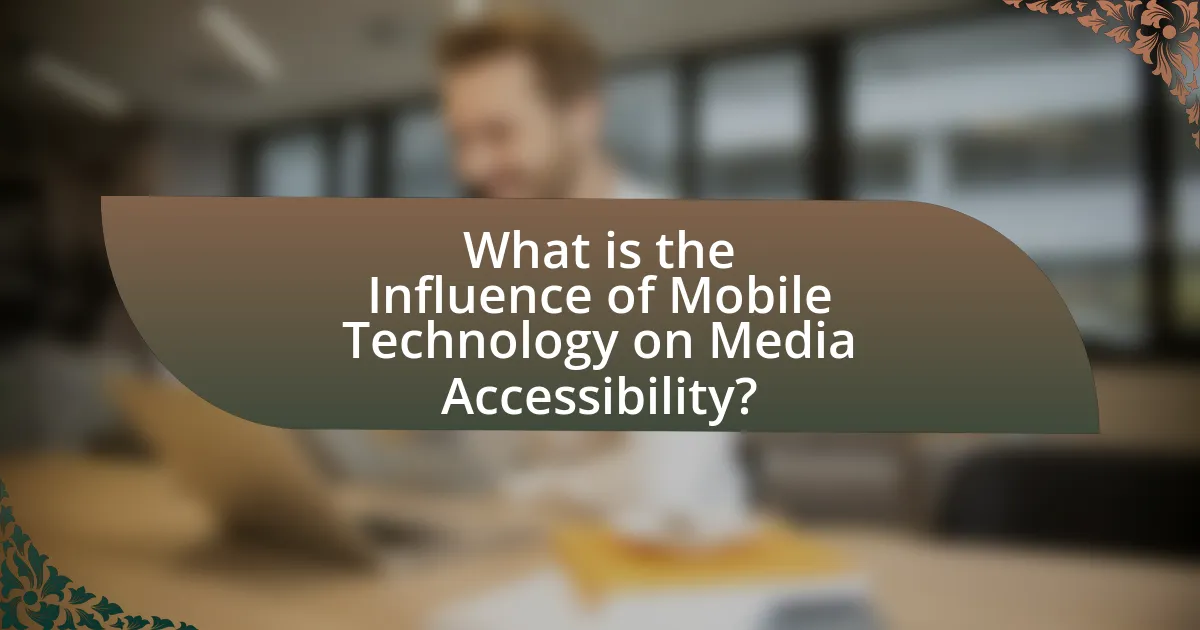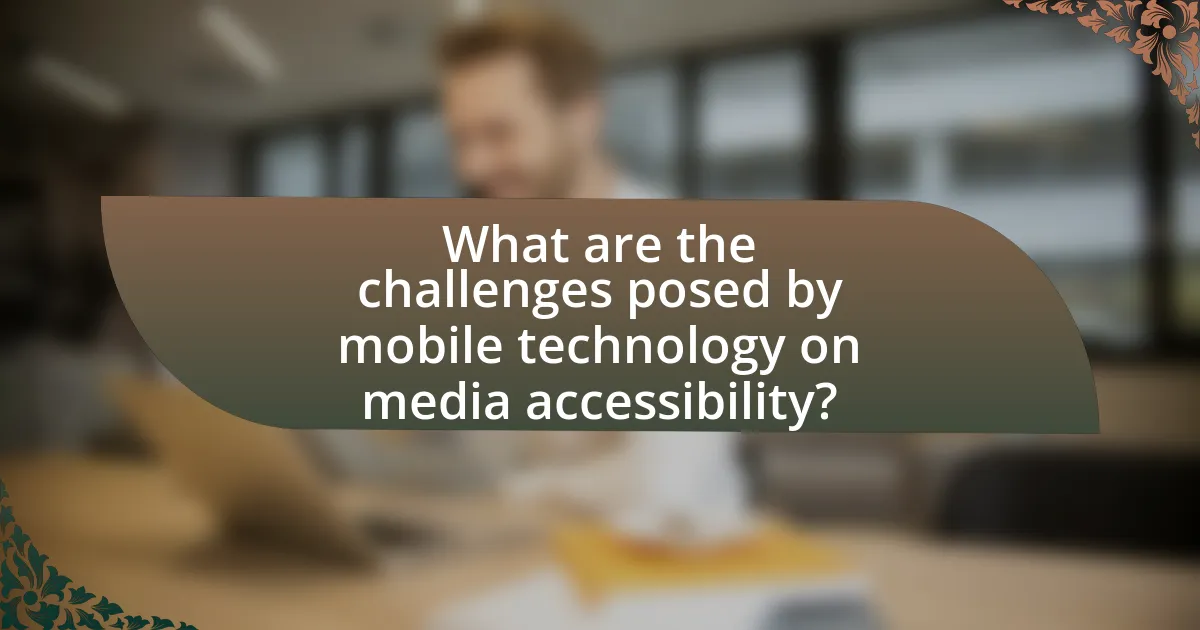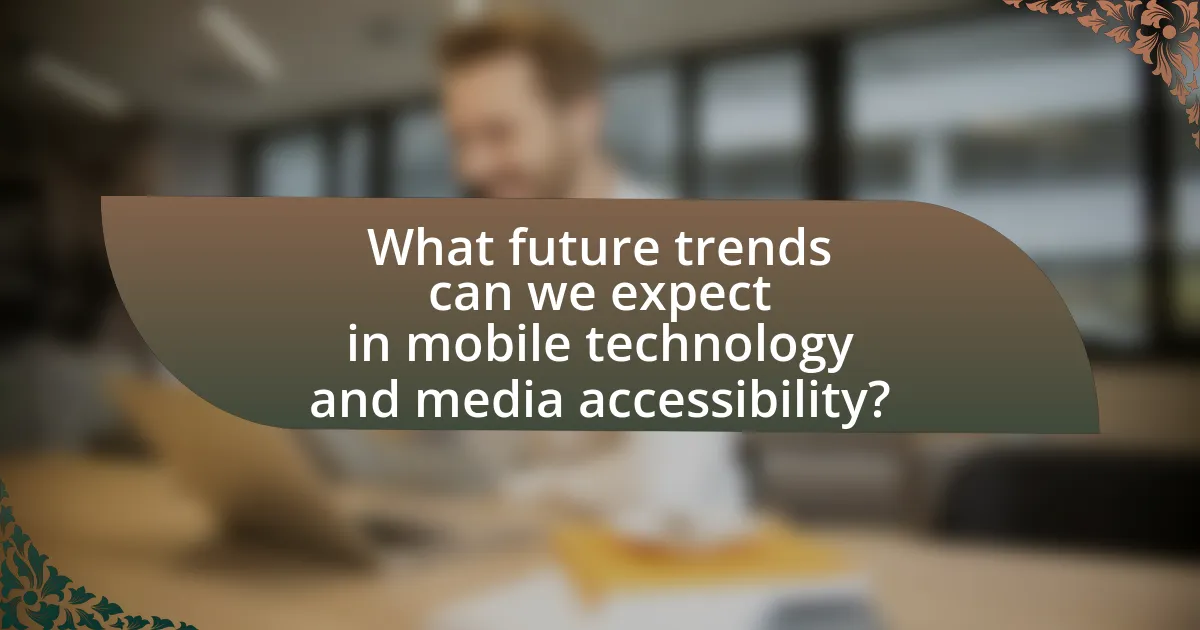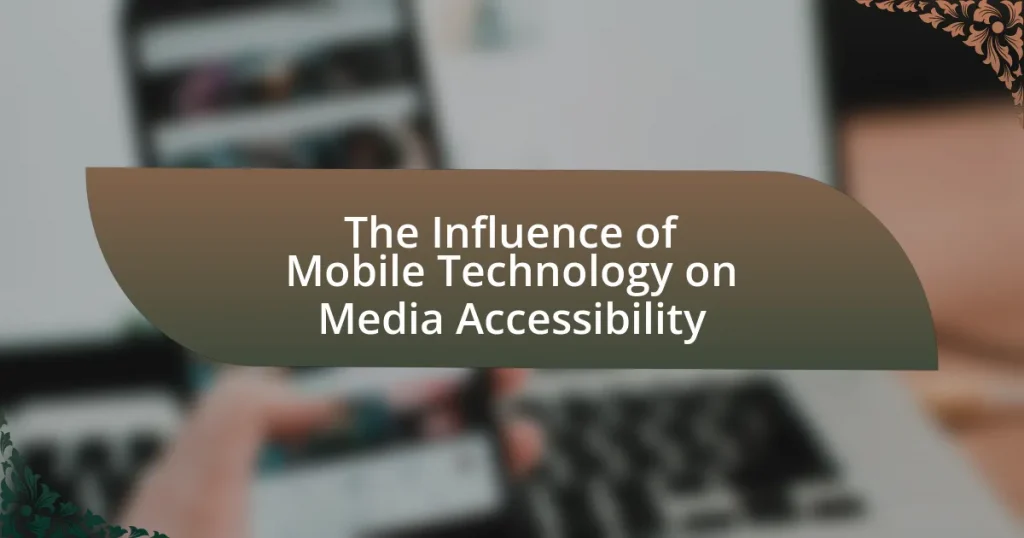The article examines the influence of mobile technology on media accessibility, highlighting how smartphones and tablets provide users with immediate access to diverse media content anytime and anywhere. It discusses the transformation of media consumption patterns, the key features of mobile technology that enhance accessibility, and the importance of inclusive media for individuals with disabilities. Additionally, the article addresses the challenges posed by mobile technology, such as inconsistent design practices and technological limitations, while exploring future trends and best practices for optimizing mobile media accessibility. It emphasizes the role of user feedback and policy changes in shaping a more accessible media landscape.

What is the Influence of Mobile Technology on Media Accessibility?
Mobile technology significantly enhances media accessibility by providing users with immediate access to information and content from anywhere at any time. This accessibility is facilitated through smartphones and tablets, which allow individuals to consume media such as news, videos, and social media on-the-go. According to a report by the Pew Research Center, as of 2021, 85% of Americans own a smartphone, which has transformed how they engage with media, making it more convenient and widespread. Furthermore, mobile technology supports various accessibility features, such as screen readers and voice commands, enabling users with disabilities to access media content effectively. This integration of mobile technology into daily life has democratized access to information, bridging gaps that previously existed in media consumption.
How has mobile technology transformed media consumption?
Mobile technology has transformed media consumption by enabling instant access to diverse content anytime and anywhere. This shift is evidenced by the rise of streaming services, social media platforms, and mobile applications that allow users to consume news, videos, and music on their smartphones. According to a report by eMarketer, as of 2023, over 90% of internet users access media through mobile devices, highlighting the dominance of mobile in media consumption. Additionally, mobile technology has facilitated personalized content delivery through algorithms, enhancing user engagement and satisfaction.
What are the key features of mobile technology that enhance media accessibility?
Key features of mobile technology that enhance media accessibility include portability, internet connectivity, and user-friendly interfaces. Portability allows users to access media anytime and anywhere, significantly increasing the likelihood of engagement. Internet connectivity enables real-time access to a vast array of media content, facilitating instant updates and streaming services. User-friendly interfaces, often designed with accessibility features such as voice commands and adjustable text sizes, cater to diverse user needs, including those with disabilities. These features collectively contribute to a more inclusive media landscape, as evidenced by the increasing number of mobile users accessing digital content, which reached over 5 billion globally in 2023, according to the International Telecommunication Union.
How do mobile devices facilitate access to diverse media formats?
Mobile devices facilitate access to diverse media formats by providing users with portable, internet-enabled platforms that support various content types, including text, audio, video, and interactive applications. These devices, such as smartphones and tablets, utilize applications and web browsers to deliver multimedia content seamlessly, allowing users to consume information in formats that suit their preferences. For instance, according to a report by the Pew Research Center, 85% of Americans own a smartphone, which enables them to access news articles, podcasts, streaming services, and social media platforms anytime and anywhere. This widespread adoption of mobile technology has transformed how individuals engage with media, making it more accessible and varied than ever before.
Why is media accessibility important in today’s society?
Media accessibility is crucial in today’s society because it ensures that all individuals, regardless of their abilities or disabilities, can access and engage with information and entertainment. This inclusivity fosters equal opportunities for participation in social, educational, and economic activities. According to the World Health Organization, over 1 billion people globally experience some form of disability, highlighting the need for accessible media to accommodate diverse audiences. Furthermore, the rise of mobile technology has significantly enhanced media accessibility, allowing users to access content through various adaptive technologies and platforms, thereby promoting inclusivity and engagement across different demographics.
What role does media accessibility play in promoting inclusivity?
Media accessibility plays a crucial role in promoting inclusivity by ensuring that all individuals, regardless of their abilities or disabilities, can access and engage with content. Accessible media allows people with visual, auditory, or cognitive impairments to participate fully in society, thereby fostering equal opportunities. For instance, the World Health Organization reports that over 1 billion people globally experience some form of disability, highlighting the necessity for accessible media to accommodate this significant portion of the population. By implementing features such as captions, audio descriptions, and screen reader compatibility, media producers can create an inclusive environment that empowers diverse audiences to consume information and participate in cultural dialogues.
How does improved media accessibility impact different demographics?
Improved media accessibility positively impacts different demographics by enhancing information access and engagement across various groups. For instance, individuals with disabilities benefit from features like screen readers and closed captioning, which facilitate their interaction with media content. According to the World Health Organization, approximately 15% of the global population experiences some form of disability, highlighting the importance of accessible media in reaching this significant demographic. Additionally, older adults, who may face challenges with traditional media formats, find improved accessibility features, such as larger text and simplified navigation, beneficial for their media consumption. Furthermore, marginalized communities, including those with limited internet access, gain from mobile technology advancements that provide affordable and user-friendly platforms for accessing news and educational resources. This broadens their participation in societal discourse and enhances their overall media literacy.

What are the challenges posed by mobile technology on media accessibility?
Mobile technology poses several challenges to media accessibility, primarily due to varying device capabilities and user interface designs. These challenges include inconsistent screen sizes, which can hinder the visibility of content, and the lack of standardized accessibility features across different platforms. For instance, a study by the World Health Organization indicates that approximately 15% of the global population experiences some form of disability, yet many mobile applications do not adequately support assistive technologies like screen readers. Additionally, the rapid pace of mobile technology advancements often outstrips the development of accessible content, leading to a digital divide where certain user groups are left behind.
What barriers exist for users with disabilities in accessing mobile media?
Users with disabilities face several barriers in accessing mobile media, including inadequate accessibility features, poor design practices, and lack of compatibility with assistive technologies. Inadequate accessibility features, such as insufficient text-to-speech options or lack of alternative text for images, hinder users with visual impairments. Poor design practices, like small touch targets and low color contrast, create challenges for users with motor or cognitive disabilities. Additionally, many mobile applications and websites do not fully support assistive technologies, such as screen readers or voice recognition software, limiting functionality for users who rely on these tools. According to the World Health Organization, over 1 billion people globally experience some form of disability, highlighting the critical need for improved mobile media accessibility.
How do design choices in mobile applications affect accessibility?
Design choices in mobile applications significantly affect accessibility by determining how easily users with disabilities can interact with the app. For instance, the use of high-contrast colors and scalable text sizes enhances visibility for users with visual impairments, while intuitive navigation and voice command features support users with motor disabilities. According to the World Health Organization, approximately 15% of the global population experiences some form of disability, highlighting the importance of inclusive design. Furthermore, adherence to accessibility standards, such as the Web Content Accessibility Guidelines (WCAG), ensures that mobile applications provide equal access to all users, thereby improving overall user experience and engagement.
What technological limitations hinder media accessibility on mobile devices?
Technological limitations that hinder media accessibility on mobile devices include inadequate bandwidth, limited processing power, and lack of standardized formats. Inadequate bandwidth restricts the ability to stream high-quality media, leading to buffering and poor user experience. Limited processing power affects the performance of media applications, causing slow loading times and crashes. Additionally, the lack of standardized formats can result in compatibility issues, preventing users from accessing certain media types across different devices. These factors collectively diminish the overall accessibility of media on mobile platforms.
How can mobile technology be optimized for better media accessibility?
Mobile technology can be optimized for better media accessibility by implementing features such as voice recognition, screen readers, and customizable user interfaces. These enhancements allow users with disabilities to interact with media content more effectively. For instance, according to the World Health Organization, over 1 billion people experience some form of disability, highlighting the need for inclusive design in mobile applications. Additionally, incorporating real-time captioning and audio descriptions can significantly improve the experience for users with hearing and visual impairments, respectively. Research from the Pew Research Center indicates that 56% of Americans have a disability that affects their daily lives, underscoring the importance of optimizing mobile technology for accessibility.
What best practices should developers follow to enhance accessibility?
Developers should follow best practices such as using semantic HTML, providing alternative text for images, ensuring keyboard navigability, and implementing ARIA (Accessible Rich Internet Applications) roles to enhance accessibility. Semantic HTML helps screen readers interpret content correctly, while alternative text allows visually impaired users to understand images. Ensuring keyboard navigability allows users who cannot use a mouse to access all functionalities. Implementing ARIA roles further enhances the accessibility of dynamic content by providing additional context to assistive technologies. These practices are supported by guidelines from the Web Content Accessibility Guidelines (WCAG), which emphasize the importance of creating inclusive digital experiences.
How can user feedback improve mobile media accessibility features?
User feedback can significantly enhance mobile media accessibility features by providing direct insights into user experiences and needs. When users share their challenges and preferences, developers can identify specific barriers that hinder accessibility, such as inadequate screen reader compatibility or poorly designed user interfaces. For instance, a study by the World Health Organization indicates that 15% of the global population experiences some form of disability, highlighting the importance of tailored feedback to address diverse accessibility requirements. By integrating user feedback into the design and development process, companies can create more inclusive mobile media experiences that cater to a wider audience, ultimately improving usability and satisfaction.

What future trends can we expect in mobile technology and media accessibility?
Future trends in mobile technology and media accessibility include the widespread adoption of 5G networks, which will enhance streaming quality and reduce latency, enabling real-time access to media content. Additionally, advancements in artificial intelligence will facilitate personalized content delivery and improve accessibility features, such as voice recognition and real-time translation, making media more inclusive for users with disabilities. The integration of augmented reality (AR) and virtual reality (VR) will also transform how users interact with media, providing immersive experiences that cater to diverse audiences. According to a report by the International Telecommunication Union, the global number of mobile broadband subscriptions reached 8.5 billion in 2022, indicating a significant shift towards mobile-first media consumption.
How will advancements in mobile technology shape media accessibility in the coming years?
Advancements in mobile technology will significantly enhance media accessibility in the coming years by enabling faster internet speeds, improved user interfaces, and increased device affordability. For instance, the rollout of 5G networks is expected to provide download speeds up to 100 times faster than 4G, allowing users to stream high-quality content seamlessly. Additionally, innovations in artificial intelligence and machine learning will facilitate personalized content delivery, making it easier for users to find relevant media. According to a report by the International Telecommunication Union, mobile broadband subscriptions reached 8 billion globally in 2022, indicating a growing reliance on mobile devices for accessing media. This trend suggests that as mobile technology continues to evolve, it will further democratize access to information and entertainment, particularly in underserved regions.
What emerging technologies could further enhance media accessibility?
Emerging technologies that could further enhance media accessibility include artificial intelligence, augmented reality, and voice recognition systems. Artificial intelligence can improve content personalization and automate captioning, making media more accessible to individuals with hearing impairments. Augmented reality can provide visual aids and contextual information, enhancing understanding for users with cognitive disabilities. Voice recognition systems enable hands-free navigation and interaction with media, benefiting users with mobility challenges. These technologies are supported by advancements in machine learning and natural language processing, which have shown significant improvements in accuracy and user experience, thereby validating their potential impact on media accessibility.
How can policy changes influence the future of mobile media accessibility?
Policy changes can significantly enhance mobile media accessibility by mandating standards that ensure all users, including those with disabilities, can access digital content. For instance, regulations like the Americans with Disabilities Act (ADA) in the United States have led to increased compliance among mobile app developers, resulting in features such as voice-over text and adjustable font sizes. Furthermore, the European Accessibility Act aims to improve accessibility across various digital services, which can drive innovation in mobile media technologies. These policy frameworks create accountability and incentivize companies to prioritize inclusive design, ultimately shaping a more accessible mobile media landscape.
What practical steps can users take to improve their media accessibility experience?
Users can improve their media accessibility experience by utilizing built-in accessibility features on their devices, such as screen readers, voice commands, and text-to-speech options. These features enhance interaction with media content, making it easier for individuals with visual or auditory impairments to access information. For instance, according to a report by the World Health Organization, approximately 2.2 billion people globally experience vision impairment, highlighting the importance of such tools in facilitating access to media. Additionally, users can customize settings like font size, contrast, and captions to suit their specific needs, further enhancing their overall experience.
How can users customize their mobile devices for better accessibility?
Users can customize their mobile devices for better accessibility by adjusting settings such as text size, contrast, and enabling assistive technologies. For instance, both Android and iOS devices offer options to increase text size and change display settings to enhance visibility for users with visual impairments. Additionally, features like VoiceOver on iOS and TalkBack on Android provide screen reading capabilities, allowing users to navigate their devices through auditory feedback. Research indicates that these accessibility features significantly improve user experience, with studies showing that 71% of users with disabilities find mobile accessibility features essential for daily tasks.
What resources are available for users seeking to enhance their media accessibility?
Users seeking to enhance their media accessibility can utilize various resources, including accessibility tools, guidelines, and training programs. Notable tools include screen readers like JAWS and NVDA, which assist visually impaired users in navigating digital content. The Web Content Accessibility Guidelines (WCAG) provide a comprehensive framework for creating accessible web content, ensuring that media is usable by individuals with disabilities. Additionally, organizations such as the American Foundation for the Blind offer training and resources to help users understand and implement accessibility features effectively. These resources collectively support the goal of improving media accessibility for all users.




